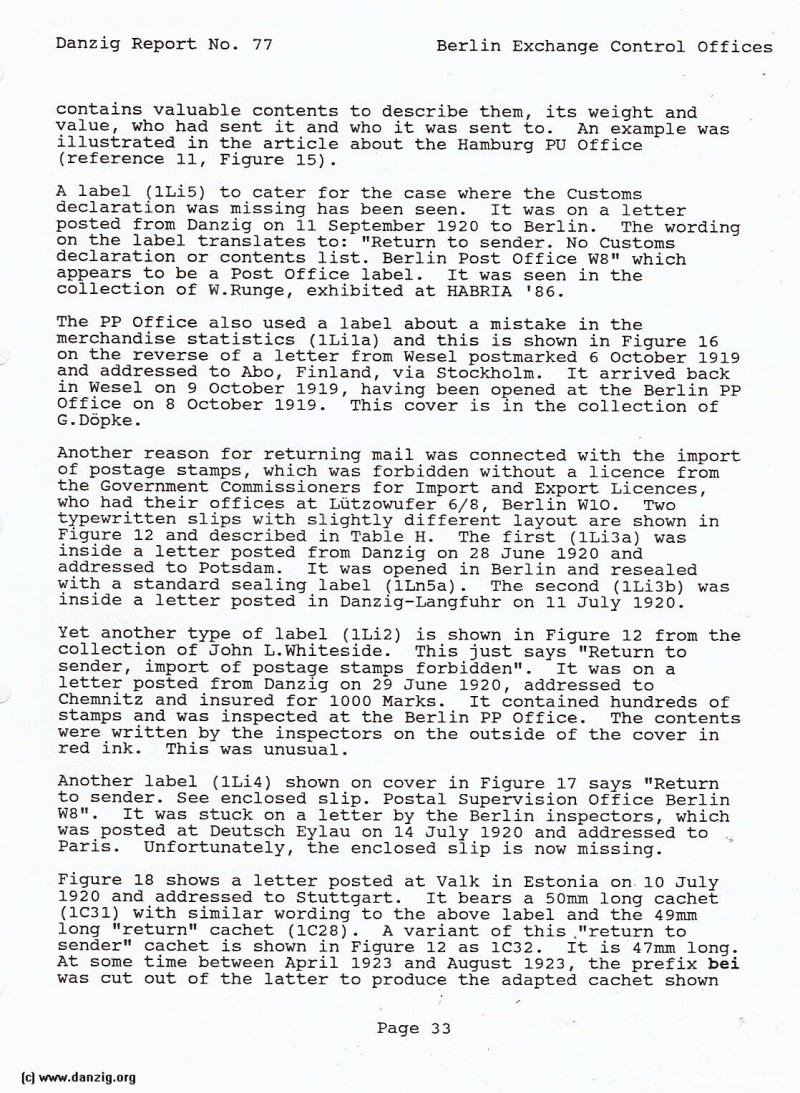
contains valuable contents to describe them, its weight and value, who had sent it and who it was sent to. An example was illustrated in the article about the Hamburg PU Office
(reference 11, Figure 15).
A label (lLi5) to cater for the case where the Customs declaration was missing has been seen. It was on a letter posted from Danzig on 11 September 1920 to Berlin. The wording on the label translates to: “Return to sender. No Customs declaration or contents list. Berlin Post Office W8” which appears to be a Post Office label. It was seen in the
collection of W.Runge, exhibited at HABRIA ‘86.
The PP Office also used a label about a mistake in the merchandise statistics (iLila) and this is shown in Figure 16 on the reverse of a letter from Wesel postmarked 6 October 1919 and addressed to Abo, Finland, via Stockholm. It arrived back in Wesel on 9 October 1919, having been opened at the Berlin PP Office on 8 October 1919. This cover is in the collection of G. Döpke.
Another reason for returning mail was connected with the import of postage stamps, which was forbidden without a licence from the Government Commissioners for Import and Export Licences, who had their offices at Lützowufer 6/8, Berlin W1O. Two typewritten slips with slightly different layout are shown in Figure 12 and described in Table H. The first (lLi3a) was inside a letter posted from Danzig on 28 June 1920 and addressed to Potsdam. It was opened in Berlin and resealed with a standard sealing label (lLn5a). The second (lLi3b) was inside a letter posted in Danzig-Langfuhr on 11 July 1920.
Yet another type of label (lLi2) is shown in Figure 12 from the collection of John L.Whiteside. This just says “Return to sender, import of postage stamps forbidden”. It was on a letter posted from Danzig on 29 June 1920, addressed to Chemnitz and insured for 1000 Marks. It contained hundreds of stamps and was inspected at the Berlin PP Office. The contents were written by the inspectors on the outside of the cover in red ink. This was unusual.
Another label (lLi4) shown on cover in Figure 17 says “Return to sender. See enclosed slip. Postal Supervision Office Berlin W8”. It was stuck on a letter by the Berlin inspectors, which was posted at Deutsch Eylau on 14 July 1920 and addressed to Paris. Unfortunately, the enclosed slip is now missing.
Figure 18 shows a letter posted at Valk in Estonia on 10 July 1920 and addressed to Stuttgart. It bears a 50mm long cachet (lC3l) with similar wording to the above label and the 49mm long “return” cachet (1C28). A variant of this ,“return to sender” cachet is shown in Figure 12 as 1C32. It is 47mm long. At some time between April 1923 and August 1923, the prefix bei. was cut out of the latter to produce the adapted cachet shown
Hits: 3303
Added: 03/07/2015
Copyright: 2025 Danzig.org

